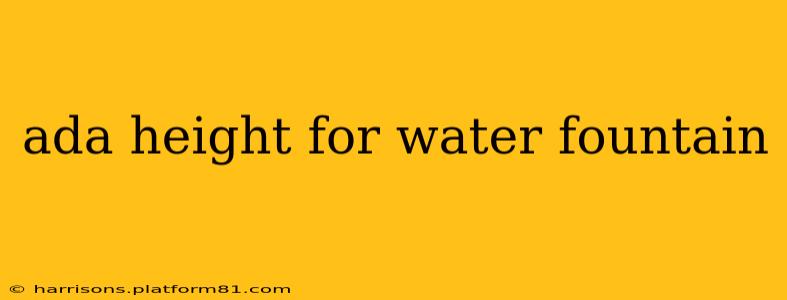Designing accessible public spaces requires careful consideration of various factors, and among them, the height of water fountains is crucial for compliance with the Americans with Disabilities Act (ADA). This guide will delve into the ADA's stipulations regarding water fountain height, providing essential information for architects, designers, and anyone involved in creating inclusive environments.
What is the ADA Standard for Water Fountain Height?
The ADA Standards for Accessible Design specify that drinking fountains should be installed at a height that allows wheelchair users to easily access them. Specifically, the spout should be between 30 and 36 inches above the floor. This range ensures that individuals using wheelchairs can comfortably reach the water without strain or assistance.
Why is the Correct Height so Important?
The seemingly simple matter of water fountain height directly impacts accessibility for people with disabilities. An improperly placed fountain can create significant barriers, preventing wheelchair users from accessing clean drinking water independently. This not only undermines the principles of inclusion but also contradicts the spirit of the ADA, which aims to guarantee equal opportunities and access for everyone.
What about Other ADA Requirements for Water Fountains?
The height is just one part of ADA compliance for water fountains. Other important considerations include:
- Clearance: There must be sufficient knee and toe clearance beneath the fountain to allow wheelchair users to approach and maneuver comfortably. Specific measurements are outlined in the ADA Standards.
- Reach Ranges: All controls, such as push buttons or handles, must be within reach for individuals using wheelchairs and those with limited reach capabilities.
- Signage: Clear and easily readable signage should identify the location of the water fountain.
- Surface: The floor surface around the fountain should be stable, level, and slip-resistant.
How Can I Ensure ADA Compliance for My Water Fountain Project?
To guarantee ADA compliance, it's essential to:
- Consult the ADA Standards: Thoroughly review the complete ADA Standards for Accessible Design for comprehensive guidelines.
- Work with an Accessibility Consultant: Collaborating with an experienced accessibility consultant can provide valuable insights and ensure your project meets all requirements.
- Use ADA-Compliant Fixtures: When selecting water fountains, choose fixtures explicitly designed and certified as ADA compliant.
What Happens if My Water Fountain Doesn't Meet ADA Requirements?
Failure to comply with ADA regulations regarding water fountain height and other accessibility features can result in legal action, fines, and potential costly renovations to bring the facility into compliance. It's far more efficient and responsible to design accessibility into the project from the outset.
Can I have a water fountain with varying spout heights?
While a single fountain with multiple spouts at different heights isn't explicitly required by the ADA, it's a thoughtful consideration that can increase accessibility for a broader range of individuals. This could particularly benefit children or shorter adults, allowing everyone to access water without difficulty.
Are there different ADA requirements for water fountains in different locations?
The core ADA requirements for water fountain height remain consistent across various locations, including schools, workplaces, public parks, and government buildings. However, local building codes may incorporate additional accessibility guidelines, so it's crucial to check both the ADA standards and local regulations.
By adhering to ADA guidelines, we can ensure that everyone has equal access to basic necessities, fostering a more inclusive and equitable society. Remember that compliance is not just about meeting regulations but about creating a welcoming and accessible environment for all members of the community.
